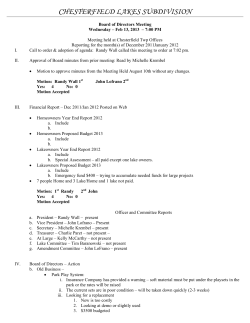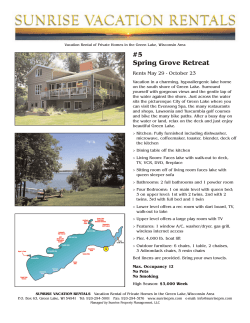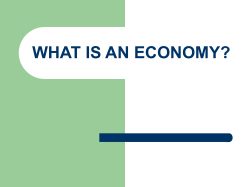
classic fast ferries WITH HYDROFOILS
HYDROFOILS HOVERCRAFT SESs & CATAMARANS NOVEMBER 2014 ISSUE 53 classic fast ferries what’s in a designation 100 YEARS WITH HYDROFOILS 100 years HYDROFOILS with Above : Freccia dei Gerani is the sole remaining RHS 70 in service in Italy. It is seen here cutting the calm surface of Lake Como, kissed by the last beams of the setting December sun last year / JACOPO MEMEO photo T H E H Y D R O F O I L S on Lakes Como, Garda and Maggiore in northern Italy have been sentenced to death. This was a fairly qualified presumption made by us back in 2003. Eleven years later hydrofoils remain in service on all three Lakes. What is more, this year marks fifty years with hydrofoils on Lago di Como and Lago Maggiore. Quite remarkable when considering that the market for the hydrofoil has dwindled into almost insignificance and no new hydrofoil has been ordered for operation on the Lakes by the Ministero dei Trasporti, Italy’s Ministry of Transport, since the late 1980s. Instead catamarans have been chosen, but unlike elsewhere these have only partly substituted the hydrofoils. The head organization of Gestione Navigazione Laghi is responsible for the ferry operation, which is being carried out by an affiliated company for each Lake. _______________________________________________________________________________________________________________________ THE ORIGINAL PERIODICAL ABOUT THE HISTORY OF HYDROFOILS, HOVERCRAFT, CATAMARANS AND SURFACE EFFECT SHIPS, THEIR BUILDERS AND OPERATORS WORLDWIDE. ALL ARTICLES AND DESIGN EXCEPT WHERE NOTED, COPYRIGHT 2014 TIM TIMOLEON / CLASSIC FAST FERRIES. COPYRIGHT OF PHOTOS HELD BY THE SOURCE INDICATED. rt 2 www.classicfastferries.com classicfastferries@gmail.com COVER : AT 25, RHS 150FL VOLOIRE IS THE YOUNGEST HYDROFOIL ON LAKE COMO. PHOTO: JACOPO MEMEO CFF 53 NOVEMBER 2014 PIONEERS As impressive as fifty years of continous service by hydrofoils is, there had been hydrofoils in the area even before this. Already in 1953 the world’s first commercial hydrofoil operation was carried out on Lake Maggiore. The craft used, Freccia d’Oro, had been designed by Baron Hans von Schertel, a German engineer, and completed by Supramar AG of Switzerland the previous year. Designated PT.10, the small hydrofoil was of the surface-piercing type, as were all Supramar designs (except for experiments with fully submerged foils) as well as all hydrofoils to follow on the Lakes. It had a length overall of 16.3 m and carried 30 passengers, all of which seated in a single saloon with a glass-top for unrestricted view of the passing scenery. The crew of two were positioned at the very front, out in the open only protected by a windshield. It would be five more years, however, before a permanent, although not necessarily yearround, hydrofoil service was established. This time on Lake Garda, which saw the introduction of a Supramar PT.20, aptly named Freccia del Garda, in 1958. Thus, this article’s slightly invented heading should rightfully read 106 years, but in this instance we particularly celebrate the operations on Lake Como and Lake Maggiore. As far as the hydrofoils go, the development regarding the fleets has been more or less identical on all three Lakes over time. Below : The first hydrofoil on Lake Como, PT.20 Freccia del Lario, entered service in 1964. Following its withdrawal in 1985 it was moored in Como for several years / TIM TIMOLEON photo CFF 53 NOVEMBER 2014 3 Above : The first PT.20 for Lake Maggiore, Freccia del Verbano, was introduced also in 1964 / POSTCARD EARLY YEARS The two PT.20s entering service in 1964 were Freccia del Lario on Lake Como and Freccia del Verbano on Lake Maggiore. In both cases they joined a fleet of conventional vessels of various shape and vintage. Both hydrofoils had of course been built in Messina by the Rodriquez shipyard, which witnessed its absolute heyday of hydrofoil building in the 1960s and 70s. Initially as a Supramar licensee constructing a large number of the successful PT.20 and PT.50 types, and later developing and building its own designs. All subsequent hydrofoils for the Lakes thus were delivered by Rodriquez. The company still exists, but has not delivered any hydrofoil for several years. Two more PT.20s followed in 1967; Freccia delle Azalee and Freccia del Ticino, respectively. Passenger ship service on Lake Como, the smallest lake in this trio, dates back to the days of paddle steamers in the 1820s. Having the shape of an inverted Y, initially the Below : RHS 70 Freccia delle Betulle was delivered in 1974 as the first of the type for Navigazione Lago di Como. Seen here in 1987, it was retired ten years ago / TIM TIMOLEON photo 4 CFF 53 NOVEMBER 2014 hydrofoil service on Lake Como did not call at towns on the eastern leg but would only operate in the western part, between Como in the south-west and Colico in the north, a distance of approximately 46 kilometres, making numerous intermediate stops. Later the service was extended to include also Lecco in the south-eastern corner of the Lake. With a surface area of 212 square kilometres, Lago Maggiore is the second largest lake. About one quarter lies within the boundary of Switzerland. The climate, as on the neighbouring lakes, is pleasantly mild in spring and warm to hot, almost tropical, in the summer ensuring a flora of outstanding beauty on the hillsides. This combined with the lovely small islands, the classic palaces and villas and the picturesque towns, all with the snow-capped mountains as backdrop, make for the perfect tourist destination. The longest route is that of Arona in the south to Locarno in Switzerland in the north, making this an international operation. Journey time by hydrofoil is about two hours. EXPANSION The introduction of fast ferries proved very popular with visitors as well as locals, including commuters. So much so that between 1974 and 1976 four more hydrofoils were added. This time by the RHS 70 type, which was basically a restyled and generally modernized version of the Supramar PT.20, developed by Rodriquez – or Navaltecnica, as the company was known for a period of time during the 1970s. The pair for Navigazione Lago di Como, Freccia delle Betulle and Freccia delle Gardenie, entered service in 1974 and 1976, and Navigazione Lago Maggiore’s two craft Freccia delle Camelie and Freccia delle Magnolie in 1974 and 1975. The next expansion in the hydrofoil fleets happened in 1980–81 when the first two of what would total four RHS 150SL type craft entered service. Freccia dei Giardini went to Lake Maggiore, in 1980, and Freccia delle Valli to Lake Como the following year. This was a considerably larger design, Above : The second PT.20 for Lake Como, Freccia delle Azalee, entered service in 1967. Here it is seen in 1992 approaching Como / TIM TIMOLEON photo CFF 53 NOVEMBER 2014 5 carrying 190 passengers on two decks, the capacity of which was well over twice that of the previous vessels. A derivation of the RHS 140 and RHS 160 types combined into one, the RHS 150SL had been tailored specially for operation on the Italian Lakes. In their standard configuration, the RHS 140 and RHS 160 would be fitted out for 125 and 160 passengers, respectively. Exteriorwise the most evident difference between the designs was the extra-large windows on the RHS 150SL, which was made possible due to the less severe conditions experienced on the Lakes – except for the occasional, usually only passing thunderstorm – and the short distance to a port of refuge, as opposed to when operating in exposed waters. While perhaps not very becoming from an aesthetical point of view, at least passengers were (and still are) able to take in the extraordinary beauty of the Lakes to the fullest. Less beautiful were the large forward fenders with built-in steps on either side of the vessel. While necessary and practical during the frequent berthing procedures and for passenger exchange, this arrangement gavewith the built-in design asteps disproportional, almost large forward fenders on either side of unwieldy the vessel.look. While practical during the frequent berthing The second pair RHS 150SLs, Guglielmo and procedures and forofpassenger exchange, this Marconi arrangement Enricothe Fermi , arrived in 1983–84. While keeping its look. gave design a disproportional, almost unwieldy designation these looked different The secondand pairoverall of RHSdimensions, 150SLs, Guglielmo Marconi and to the first generation 150SL,While featuring a raised Enrico Fermi , arrived inRHS 1983–84. keeping its wheelhouse, first seen on an RHS 150 in 1980, tolooked allow for a bow designation and overall dimensions, these different 6 CFF 53 NOVEMBER 2014 saloon with forward facing view and a small increase in passenger capacity to 196. The panoramic windows and fenders were the same. The number of seats was later reduced on both these designs. LAST ORDERS, GENTLEMEN! The last two hydrofoils ordered for Lakes Como and Maggiore, Voloire and Lord Byron, arrived in 1989. Designated RHS 150FL, again, these looked different to the ones before them. Basically they were a cross between the RHS 150SL and RHS 150F, a new Rodriquez design which had appeared in 1984. The RHS 150FL featured a raised wheelhouse and forward saloon, just as on the RHS 150SL, whereas on the RHS 150F the bridge was on the same level as the main deck saloon. As before, the Lake operators had opted for high-density seating for up to 200 passengers, whereas in its standard configuration the RHS 150F carried a total of 151. The window arrangement was now the same as on other Rodriquez hydrofoils. Above : RHS 150SL Freccia delle Valli, delivered 1981, in aRHS breathtaking setting aon Lake Como from the first in generation 150SL, featuring raised Januaryfacing last year. wheelhouse to allow for a bow saloon withinforward designinbears a strong resemblance to the view and a smallThe increase passenger capacity to 196. The RHSand 140fenders and RHS 160 but features panoramic windows were thedesigns, same. The extra-large windows and is equipped with likewise number of seats has later been reduced on both these extra-large forward fenders designs. / JACOPO MEMEO photo Above : PT.20 Freccia del Ticino in Navigazione Lago Maggiore’s shipyard at Arona in 1987. The vessel had been delivered twenty years earlier / TIM TIMOLEON photo Below : Also at Arona, but on a later occasion, and having seen better days is RHS 70 Freccia delle Magnolie. It entered service in 1975 / MARCELLO BALDRATI photo CFF 53 NOVEMBER 2014 7 For obvious reasons, hydrofoils look their most impressive in full flight – and when high and dry, as in this view. Delivered in 1984, RHS 150SL Enrico Fermi is seen in Navigazione Lago Maggiore’s maintenance shed at Arona in August 1987. The vessel remains in service / TIM TIMOLEON photo All six of these craft remain on the roster of active hydrofoils. However, Freccia delle Valli is currently out of service following an incident in March last year when it collided with another vessel by which the starboard fender was damaged and the bow foil pushed slightly rearward. It is still uncertain when, or if, the hydrofoil returns into service. Of the smaller hydrofoils only two still exist. But – and this is quite interesting – the sole remaining RHS 70 in service on Lake Como, and indeed in all of Italy, Freccia dei Gerani, was not originally delivered here but to Navigazione Lago di Garda in 1977. It was transferred to Lake Como in 1993. It has faced the threat of withdrawal more than once since, but still has to announce its farewell tour. The vessel is being very well looked after by the maintenance staff, almost like a child, and while a preservation by the owners has not been confirmed, there is a strong interest by certain private individuals in doing so, especially since no other of the early hydrofoils has been saved in Italy. The other RHS 70 still around, Freccia delle Betulle, has not seen service for some ten years and is sitting in the water at Navigazione Lago di Como’s shipyard. Furthermore, a 1965-built PT.20, Freccia degli Ulivi, was also transferred from Lake Garda, in 1982, but never entered service on Lake Como. It was acquired for spare parts and eventually scrapped in 1994. Yet another RHS 70, Freccia del Benaco, changed hands in 1994 when it was transferred from Lake Garda to Lake Maggiore and renamed Freccia delle Ortensie. ONE–WAY TICKET An interesting detail about the hydrofoils destined for the Italian lakes is how they got there. They would travel under their own power from Messina up the Adriatic coast to Venice and, partly disassembled, taken by road piggyback to the Lake in question where they were reassembled. For all the obvious reasons a journey each vessel would make only once during its lifetime. Consequently, all maintenance work, big and small, is being carried out locally. On Lake Como the shipyard is based in Dervio and on Lake Maggiore in Arona. Needless to say, no matter how well maintained, the present hydrofoils cannot go on forever. Apart from the fact that it takes time to build a new hydrofoil, Rodriquez has only produced its Foilmaster design in more recent times and this may prove too large for the requirements on the Lakes. Another interesting possibility is Ustica Lines’ recent entry into hydrofoil production. So far only the prototype Admiral for Ustica Lines itself has been completed and as this design shares the dimensions and passenger capacity with the Foilmaster it may remain just an interesting prospect. cff Below : Second generation RHS 150SL Guglielmo Marconi exchanging passengers on Lake Como in October 2014. They may not be beautiful, but the large fenders with built-in steps on the Lake hydrofoils do come in handy when berthing. Also note the added exhaustion pipe down the side / PARAS NOTARAS photo CFF 53 NOVEMBER 2014 9 10 CFF 53 NOVEMBER 2014 LORENZO COLOMBO photo designation PAGE 11 MARCELLO BALDRATI photo WHAT’S IN A see > Left : RHS 150F Dynasty entered service with Aliscafi SNAV in 1984. It later operated for a short while in the Caribbean before returning to Italy and SNAV. The two production craft that followed were given the designation RHS 150M. The design is easily confused with the RHS 160F in its Australian version (see back cover), / TIM TIMOLEON photo The Rodriquez RHS 150 is not one but six THIS INVENTORY SHOULD HELP STRAIGHTEN THINGS OUT PAGE Top : The one-off RHS 150 10 Alijumbo Secondo, also known as Alijumbo 2, entered service with Aliscafi SNAV in the Bay of Naples in 1980. Its styling previewed that of the second generation RHS 150SL for the Italian Lakes, although the latter featured much larger windows. The vessel was sold in Mexico in 1983 and renamed Xel-Ha. Reportedly, it was only briefly operated here / RODRIQUEZ photo Centre : Three of the second generation RHS 150SL were delivered in 1982–84 to Lakes Garda, Como and Maggiore. Guglielmo Marconi entered service with Navigazione Lago di Como in 1983. All three vessels remain in service / MARCELLO BALDRATI photo Bottom : A total of three were built also of the first RHS 150SL version. A cross between the RHS 140 and RHS 160, the styling bears a particularly strong resemblance to the latter, except, again, for the non-standard windows and large forward fenders. Freccia dei Giardini was delivered to Navigazione Lago Maggiore in 1980, the same year as the sole RHS 150 (top), and is seen here in 2009 / LORENZO COLOMBO photo The RHS 150FL is not a far cry from the original RHS 150 and strongly resembles the RHS 150F, except for the bridge arrangement. These are the last hydrofoils ordered for operation on the three Lakes in northern Italy. Again, three were built, in 1988–89. Lord Byron is normally used on Navigazione Lago Maggiore’s international service to Switzerland / MAURIZIO GADDA photo CFF 53 NOVEMBER 2014 11 last but not least ... WHAT’S IN A designation At a glance, these two vessels look as like as two peas. But they are actually two different designs. Seen berthed stern-on at Napoli’s Molo Beverello terminal in 2007 are RHS 150M Salina (left) and RHS 160F Fast Blu. The former is the production version of the RHS 150F, although it is sometimes also being referred to as an RHS 150F. It was delivered to SNAV in 1990 along with sister vessel Panarea. Fast Blu is one of two non-standard RHS 160Fs delivered to Sydney, Australia in 1984-85. On the Australian craft the wheelhouse is on main deck level whereas on the standard RHS 160F it is raised. Originally named Sydney, the vessel was imported back into Italy in 1992, together with the other RHS 160F and two more Sydney hydrofoils, and put into service in north-western Italy by SNAV and local ferry company Navarma Lines under the marketing name of Moby Fast. The hydrofoil would revert to SNAV’s regular route network in September 1992. / STEFANO GUARINO photo
© Copyright 2025









